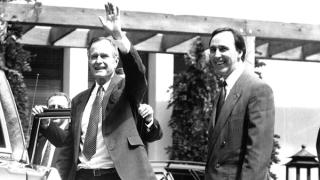In the second half of the 20th century, it was apparent the significance of the United Kingdom for Australian national security – and prosperity – was waning. But this did not automatically translate into unbridled Australian enthusiasm for its Alliance with the United States.
In 1966, Australian Prime Minister Harold Holt said Australia would go ‘all the way with LBJ’ but within a few years, it was apparent the Vietnam conflict would end badly for the United States and Australia. Going ‘all the way’ was not going well and one of its legacies was a generation of Australians more sceptical and wary than their parents of the United States.
This tempered enthusiasm for the Alliance and resulted in a reassessment, on both sides of politics, of the role of the Alliance in Australian national security. This would remain the case until a spectacular and swift falling out between New Zealand and the United States in the 1980s around New Zealand’s ‘no nukes’ policy fundamentally reshaped the operation and scope of ANZUS.
A consequence was Australia and the United States drawing closer, with the annual Australia-United States Ministerial Consultations (AUSMIN) becoming a centrepiece of a more dynamic and consultative phase of the Alliance.
Lyndon Baines Johnson was a popular president who shepherded his nation through the shock of President John F Kennedy’s assassination in 1963 before winning the election in 1964 with what remains the third widest popular margin in American history, more than 15 million votes.1
His vision to build ‘A Great Society’ with quick action on civil rights and health, among others, satisfied the American people and foreign allies, including an Australian prime minister. Theirs would be the closest relationship between a US president and an Australian leader.
Holt and Johnson first met in Melbourne in 1942, when Johnson worked as an observer on bomber missions while stationed in New Zealand and Australia.2 He had been appointed a lieutenant commander in the US Naval Reserve and transferred to the headquarters of the Twelfth Naval District, San Francisco, for inspection duty in the Pacific area. Among Johnson’s war-time adventures was an emergency landing in 1942 at a remote station near Winton in western Queensland.3 Holt was a member of Robert Menzies’ UAP–Country minority government and the Advisory War Council at the time. He served briefly in the Australian Army earlier in the war while sitting as a member of the Australian Parliament.
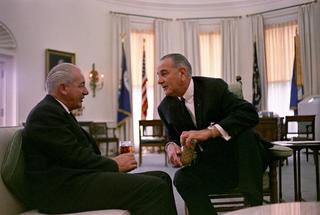
Almost a quarter of a century later, Johnson was quick to congratulate Holt on becoming prime minister, after Robert Menzies’ retirement in 1966. Holt promptly visited the United States twice that same year where, while delivering a ceremonial address at the White House, he went off script and said ‘in the lonelier and perhaps even more disheartening moments which come to any national leader, I hope there will be a corner of your mind and heart which takes cheer from the fact that you have an admiring friend, a staunch friend that will be all the way with LBJ.’4
Holt was borrowing a tagline from Johnson’s 1964 presidential campaign but it was viewed back home by critics of the Alliance as an indication of Australia’s sycophancy to the United States.5
Most Australians didn’t seem to mind. They fawned when President Johnson bolstered the camaraderie with Holt while making the first visit by an incumbent US president to Australia, in October 1966. His three-day visit taking in five cities (Canberra, Melbourne, Sydney, Brisbane and Townsville) was largely ceremonial and a show of gratitude for Australia’s emphatic support for the Vietnam War.6 Australian leaders were surprised by his reception. Nearly a million people lined Sydney streets to catch a glimpse of the presidential motorcade on its way to a state reception at the Art Gallery of NSW, where a bush park of native animals including koalas, kangaroos, wallabies and an echidna was assembled.7 Johnson was an amiable guest, saying ‘your plains, your hills, and your bush country, your cattlemen, your cattle, and your sheep remind me of my native land of Texas.’8 The only bumps in the tour were some minor protests, including paint thrown at, and protestors lying in front of, his car. This led to the perhaps apocryphal story of NSW Premier Robert Askin saying, ‘Run the bastards over!’ while riding in the presidential car.
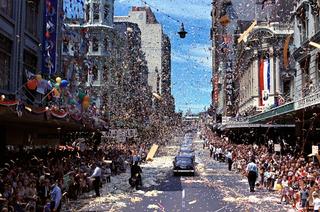
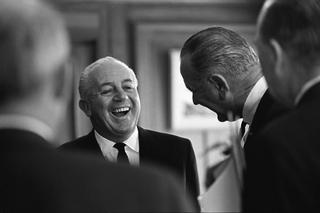
President Johnson returned to Australia in 1967 for the funeral of his friend, who disappeared, presumed drowned off Portsea beach.
The following decades were a testing era for Australia and the United States with the failure in Vietnam casting a long shadow. During the 1970s and 80s, the Alliance slowly developed into a more consequential relationship. But it would take time.
The sanguine 70s
Malcolm Fraser, in his first major foreign policy statement as prime minister in 1976, acknowledged a wariness about the Alliance when he said, ‘In our relations with the United States, as in our relations with other great powers, our first responsibility is independently to assess our own interests. The United States will unquestionably do the same.’9
Fraser’s Cabinet was also warned not to overstep as previous Australian governments had by pushing the United States for definitions of the extent of ANZUS responsibilities or threatening the status of the joint facilities. America did not appreciate the badgering.10
Recognition of the limits of the Alliance emerged under the Fraser government, which began in 1976 with Australia’s first Defence white paper that recognised it would not be ‘prudent to rely on US combat help in all circumstances,’ despite there being some confidence the United States would support Australia in the event of a fundamental threat.
Fraser and his Foreign Affairs Minister Andrew Peacock visited the United States in the same year and met President Gerald Ford’s Secretary of State Henry Kissinger and Secretary of Defense Donald Rumsfeld. Fraser asked them to draw China into the international community.
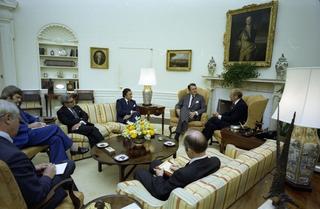
Kissinger baulked, saying the Chinese were ‘the most cold-blooded balance of power specialists in the world.’11 Yet Kissinger at the time was the architect of a US strategy embracing China, to a point, partly to drive a wedge between it and its communist ally, Russia.
The United States and Australia didn’t grow closer during Jimmy Carter’s presidency. Australia was less than enthused by Carter’s statement in March 1977 that he would try to move towards demilitarisation of the Indian Ocean ‘consulting closely with our allies and friends,’ after a UN declaration in 1971 stated it should be a ‘Zone of Peace.’ Fraser feared if this were to happen, Carter might make an agreement with the Soviets that would take precedence over ANZUS.
Prime Minister Fraser was also dismissive of Carter’s wishy-washy personal style and soft foreign policy stance.12 And in a 1977 conversation between the Australian Ambassador to the United States, Alan Renouf, and US Assistant Secretary of State for East Asian and Pacific Affairs Richard Holbrooke, Renouf expressed the Australian view that ‘Australia has memories of being taken for granted by the United States (in part her own fault). The present Australian Government is keenly aware of this and is determined that it will not happen again.’13
That thought dissipated in 1979, when the Soviets invaded Afghanistan and President Carter announced a boycott of the 1980 Moscow Olympics, without consulting US allies, and asked them to follow. Given Australia’s fervour for punching above its weight on the global stage in sport, this posed a wrenching dilemma for the Australian Government and many athletes.
At the time, Prime Minister Fraser appeared to support the US move for the broader notion of maintaining a rules-based international order. He said ‘The Soviet Union has moved a very large and powerful army into Afghanistan, a small, inoffensive, non-aligned country. There is no justification for their move whatsoever. The Soviet Union has to understand that the Western world, independent nations of the world, are prepared to take actions to bring home their abhorrence and repugnance of that active invasion and suppression of a people. That is what it is all about.’14
The Australian Olympic Federation, after deciding by one vote to allow athletes to go, announced the Australian team would march behind the Olympic flag instead of the customary Australian flag at the opening ceremony in Moscow. Despite Fraser’s opposition, he didn’t refuse individual athletes permission to travel.15
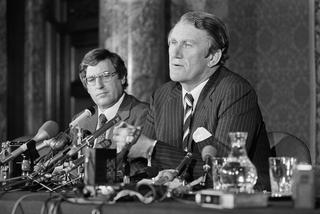

Ultimately, only 120 of a selected 242 Australian athletes competed in Moscow and among the missing were medal favourites including sprinter Raelene Boyle, the men’s hockey team and swimmer Tracey Wickham.
Decades later, Fraser conceded his regrets about the boycott.16 At the time, his caution was clear when he sent personal messages to gold-medal winners, including the 4 x 100-metre medley relay swimmers Neil Brooks, Mark Tonelli, Peter Evans and Mark Kerry: ‘You know that I did not, and do not, approve of Australia being represented at these Olympic Games. I do want to say, however, that your performance in the relay was a truly great sporting achievement. My personal congratulations. Malcolm Fraser.’17
Fraser’s, and Australia’s, disdain for the Soviet invasion was broadly aligned with the position of the United States. At the same time, the prime minister’s cooling on the United States was clear when he outlined to Parliament, on 11 September 1980, the four pillars of Australian foreign policy, the first being the ‘Western alliance,’ not Australia’s Alliance with the United States.[^18]
The Honourable Alexander Downer AC
Minister for Foreign Affairs (1996-2007)
The Alliance between Australia and the United States goes back way before 1951. Some will argue its birth was on the battlefields of Europe in the First World War, while others will claim its origins lie in the arrival of the Great White Fleet in Australia during the prime ministership of Alfred Deakin.
The fact there should be any debate at all illustrates a deeper point: the relationship between Australia and the United States is born out of a common vision of the world, common values and common aspirations. Our two countries are in many ways very different, including socially, but we do share the same fundamental values and vision for how humanity should interact and live together.
The ANZUS Treaty is part of a continuum in that relationship. Although it was negotiated and signed in the wake of the NATO alliance and straight after the Second World War, it has much more fundamental meaning than a simple commitment to common defence.
Indeed, academics and commentators frequently perceive ANZUS through the lens of a mechanism designed to defend Australia in the event of it being subjected to a military attack. Certainly, it would come in handy for Australia should that ever happen!
For the Australian foreign minister, the defence minister and even the prime minister, ANZUS has a much more profound raison d’etre. In 1996 at the AUSMIN summit in Sydney – which was the first I attended as foreign minister – we signed the Sydney Declaration. For some reason, this has been largely forgotten but it was an attempt by the new Australian Government to articulate jointly with our American visitors what ANZUS meant to us in practice. That Sydney Declaration is as relevant today as it was 25 years ago.
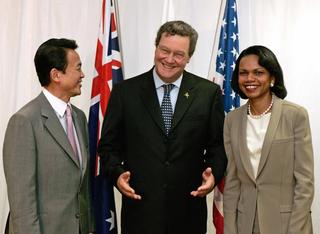
First and foremost, from Australia’s perspective, the ANZUS Treaty is designed to anchor the United States in the security architecture of what today we call the Indo-Pacific region. The deeper and the more permanent the US engagement in the region, the less likely the region is to fracture and the status quo be challenged, or even changed, by the use of force.
Or put another way, the US presence in the region helps to underwrite a regional balance of power. Take away that balance and the region would become deeply unstable.
The two key alliances that keep the United States anchored in our region are the Alliance with Australia in the south and the alliance with Japan in the north. Although the United States has other allies in the region, these two alliances are the most substantial and enduring.
Secondly, the Alliance with the United States gives Australia access to the best of American military technology. This is frequently overlooked by critics of the Alliance. Although Australia is a rich country, its small population and its huge size present a number of challenges when structuring the defence force.
Australia has no choice but to depend on the very best technology for its security and the security of its region. Australia simply doesn’t have the size or the capacity to develop that technology itself. The Alliance gives us that edge over other regional countries not in alliance with the United States.
Thirdly, the Alliance gives us access to American intelligence. This is a huge advantage for Australia. We have access to information which almost no other country in the region has – even Japan. That gives our diplomacy a major advantage. The Americans also gain out of this relationship as Australian intelligence in its own neighbourhood is equal to none.
Finally, Australia’s intimate Alliance, its access to American technology and intelligence and extensive bilateral diplomatic engagement, as well as economic links, enhances very substantially Australia’s status in the region. Given the United States’ huge power both militarily and economically, relations with the United States matter to every nation in the Indo-Pacific.
Neighbours know we have a closer relationship with the US military, the US intelligence community and many aspects of the US economy than any other nation in the region. That enhances Australia’s soft power and status in the region. In my nearly 12 years as foreign minister, I was very conscious regional neighbours knew Australia, more than any other Indo-Pacific country, had the ear of Washington. There were many occasions in that period when we exercised that influence to guide successfully American policy on issues as wide-ranging as China, Indonesia and the Asian financial crisis.
It is heartening there is limited political controversy in Australia about the continuation of ANZUS. It is equally heartening there are few voices in the United States calling for its disbandment. The Alliance in its present form has lasted for 70 years and all the signs are that it will last for another 70 or more.
ANZUS split prompts ausmin
In 1984, New Zealand refused to allow nuclear-powered or nuclear-armed ships or submarines in its ports. Given the US Navy refused to confirm or deny the presence of nuclear weapons aboard its ships, this closed NZ ports to all US Navy ships. In response, the United States formally suspended its security guarantee to New Zealand under the trilateral ANZUS Treaty.19 On the same day, 11 August 1986, Australia and the United States exchanged letters reaffirming their commitment under the Treaty.20 This unwittingly led to the greater formalisation of the US-Australian Alliance.
The regular ANZUS Council of Foreign Ministers, which had served as the primary forum conducted within the ANZUS framework, was now redundant.
AUSMIN, an annual meeting of Australian and US foreign and defence ministers and senior intelligence, military and diplomatic officials, emerged as its replacement.
Australia and the United States met for the first AUSMIN in Canberra in 1985, with principals the US Secretaries of State (George Shultz) and Defense (delegate, Admiral William Crowe) and the Australian Ministers for Foreign Affairs (Bill Hayden) and Defence (Kim Beazley).
The discussion of major global and regional political issues at AUSMIN has become a primary source of agenda-setting and decisively strengthens the Alliance, featuring regular, uninterrupted personal time in a ‘2+2’ meeting of strategically important ministers.
AUSMIN also allows grievances and disagreements to be aired, such as at the 1994 meeting, when Australia voiced its concerns about US policy towards China and Japan. That year’s AUSMIN, which had been delayed a year due to the Middle East Accord negotiations, saw Secretary of State Warren Christopher, Under Secretary of Defense Frank Wisner, and Australian Ministers Gareth Evans and Robert Ray clash over the US-Japan trade stand-off wherein the United States wanted Japan to open trade to all markets.23 The means of dealing with Chinese human rights violations was also a sticking point, just as the Alliance partners were pushing to elevate the Asia-Pacific Economic Cooperation (APEC) forum.
AUSMIN was also a welcome forum during a tense period in the relationship in 1999 when Australia led the International Force East Timor (INTERFET) securing a peaceful transition for East Timor’s independence from Indonesia. Prime Minister John Howard asked for American ‘boots on the ground,’ which didn’t arrive, prompting critics to reiterate claims ANZUS was worthless.24 Yet the United States provided strong diplomatic, intelligence and logistic support and the Americans thought this was the way allies should work, carrying the weight in their own neighbourhoods.


The Sydney Declaration from the 1996 AUSMIN was a key moment in the relationship, reaffirming the ‘mutual commitment to the obligations flowing from the [ANZUS] Treaty’ and it being ‘a crucial element in the United States’ permanent presence in the Asia Pacific region.’21 This asserted a strength and relevance for the Alliance soon after the crisis in the Taiwan Straits, in which Australia supported American naval manoeuvres helping Taiwan. China sceptically viewed the Sydney Declaration as Australia siding with a US policy of containment.
Taiwan remains a litmus test for the ANZUS Treaty. Former senior Pentagon official Richard Armitage said if ‘Washington found itself in conflict with China over Taiwan, it would expect Australia’s support. If it didn’t get that support, that would mean the end of the United States-Australian alliance.’22
The 2012 AUSMIN in Perth was also tense,25 coming soon after US officials, Pacific Commander Admiral Samuel Locklear and Assistant Secretary of State Kurt Campbell, expressed their concern at the trajectory of Australian defence spending (in 2012/13 Australia’s defence budget was 1.56 per cent of GDP, down from 1.8 per cent the previous year26). Australian Foreign Minister Bob Carr also forewarned the Americans they didn’t want to be surprised by a new military announcement at AUSMIN.27
America’s representatives, Secretary of State Hillary Clinton and Defense Secretary Leon Panetta, raised concerns about Australian defence spending cuts before pushing for advances in defence and space cooperation. While the meeting was constructive, tension was obvious in the closing media conference when Carr said ‘AUSMIN concluded its meeting today very much in a spirit of business as usual, steady as she goes, no new strategic content or announcements but a matter of consolidation.’ Secretary Clinton quickly upbraided him, saying, ‘If you look at what we’re doing, and Minister Carr gave a brief overview, it’s quite extensive.’28

Major outcomes from AUSMIN have included the Memorandum of Understanding on Ballistic Missile Defense (2004) to protect Australia from ballistic missile proliferation, the Space Situational Awareness Partnership (2010) to better monitor and track orbiting space-based objects, and the US Force Posture Agreement (2014).29 The 2014 understanding formalised plans to increase the rotation of US Marine Corps troops through Darwin, embark on trilateral military exercises in Southeast Asia, and enhance aircraft and naval cooperation and the interoperability of special forces.
AUSMIN begets APEC
In step with the early meetings of AUSMIN, the idea of broader Indo-Pacific economic cooperation and political engagement had emerged but it needed a push to gather momentum.
It came with Prime Minister Bob Hawke’s speech in Seoul in 1989 calling for the creation of a new regional group and more effective economic cooperation in the Indo-Pacific. He noted the region’s countries were interdependent and their economic futures linked although their growth was threatened by the broader General Agreement on Tariffs and Trade (GATT) talks, which had recently broken down in Montreal.30
A successful GATT would bolster the multilateral system that helped Asia respond to trade blocs being created in Europe and North America. Hawke argued effective regional cooperation would help future GATT rounds, giving ‘a vital boost to the liberalisation and therefore the preservation of the GATT-based trading system.’
‘We must work together to save the GATT system,’ he said. ‘The region’s role will be critical given its strong growth, reliance on trade and growing world importance and responsibility.’31
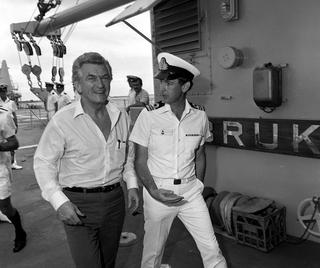
Hawke didn’t mention the United States although both Japan and the United States later mentioned the necessity of their involvement in any such regional grouping (Japan had been pursuing its own model).
Hawke appointed his Department of Foreign Affairs and Trade Secretary Richard Woolcott as his special envoy for the creation of the proposed new institution and wrote to every regional leader before Woolcott embarked on a regional roadshow selling the proposition.
Malaysia was the only country among the six Association of Southeast Asian Nations (ASEAN) – Brunei, Indonesia, Malaysia, the Philippines, Singapore and Thailand – not wanting the United States to join. Woolcott met President George HW Bush’s Trade Representative Bob Zoellick, who advised him the Americans were miffed they had not been consulted.
Indeed later, US Secretary of State James Baker privately gave the Australian Foreign Minister Gareth Evans ‘both barrels’ while expressing Washington’s extreme displeasure at Australia launching such a major initiative without consulting them. Evans later wrote he was subjected to ‘a carve up.’32
So America’s involvement was a fait accompli and it advised Australia to keep leading the initiative, so it would appear like an autonomous move by a smaller country (which it still was) rather than by a titan like Japan or the United States.
Soon after, the United States formally agreed to join the burgeoning group. The Sydney Morning Herald described it as ‘Australia’s most important foreign policy victory for a decade,’ although joked blackly the APEC forum remained ‘four adjectives looking for a noun.’33
Evans chaired the inaugural APEC Ministerial Meeting on 6-7 November 1989 under a rain-sodden temporary marquee in Canberra, featuring 26 ministers from 12 major trading nations: the United States, Canada, Japan, South Korea, Australia, New Zealand and the six ASEAN nations.
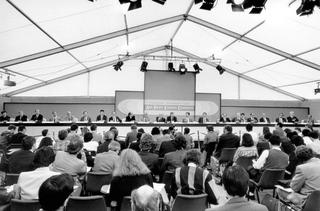
At the time, more than half of Australia’s exports went to Indo-Pacific countries and about 40 per cent of its imports, and even more of its foreign investment, were sourced from the region. Consequently, Australia wanted APEC to encourage free trade, develop cooperative projects and protect regional interests in the GATT trade talks but the ASEAN nations only wanted a loosely consultative organisation. They made it so by establishing an exclusive ASEAN free trade area for 15 years in 1992.
By 1991, APEC extended its membership to 21 nations, including China and Russia.
“APEC was only a concept. Australia’s timing and skilful diplomacy brought it to fruition.”Prime Minister of Singapore Lee Kuan Yew, APEC in Singapore, 1990
That year, incoming Australian Prime Minister Paul Keating – a former Treasurer himself – saw more potential in APEC than mere economic cooperation. He later wrote of his sense ahead of President George HW Bush’s visit to Australia in 1992, the first by an American president in 25 years, ‘I was determined that the warm fog of sentimentality that swirls around the relationship between the United States and Australia so easily on these occasions shouldn’t obscure the opportunity.’35
Keating’s enthusiasm for a more consequential APEC came after realising Japan and China had no contact with, and little understanding of, each other. The political architecture of north Asia needed a foundation.
Keating met Bush on New Year’s Day 1992, 12 days after he became prime minister, overlooking a summer’s Sydney Harbour at Kirribilli and warned him to avoid splitting the globe into three separate trading blocs: Europe, Asia and the Americas. It became apparent the United States was already worried about the emerging ASEAN regional forum and a possible complication could have been the Bush administration’s satisfaction with bilateral agreements in the region.
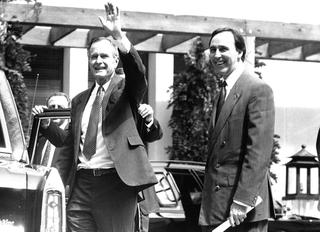
The United States preferred a hub-and-spoke strategy in the region, rather than possibly unwieldy multilateral agreements where its power could be diluted.37
Keating proposed a heads of government body in the Indo-Pacific to encourage a regionalism unheard of during the Cold War. Four months later, Bush wrote to Keating telling him to take the lead because ‘too prominent a US role could be counterproductive.’38
The approval of the unaligned Indonesian President Soeharto was the crucial first hurdle, which Keating cleared, before he won over Japan, China, South Korea and Singapore by mid-1993.
When Bill Clinton won the 1992 presidential election, Keating offered him an early foreign policy win if he were to embrace this new concept. President Clinton said he would support an Asia-Pacific leaders’ meeting if it was an economic cooperation and trade body. Keating wanted something higher level and politically strategic, so he used the APEC template and acronym for the leaders’ meeting to ensure Clinton’s support.39
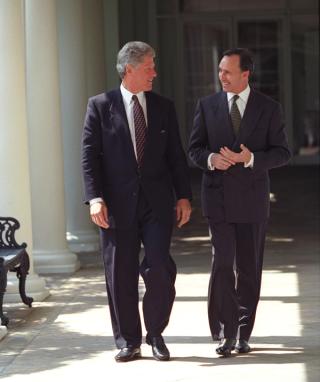
Keating won that support. After the 1992 APEC meeting, Clinton extended an invitation to the inaugural Asia-Pacific Leaders’ Meeting following APEC the next year in Seattle, the home of Boeing and Microsoft.
Beyond bringing together the key leaders of the region, the Leaders’ Summit has added potency to the bilateral and sector meetings preceding it and brought focus to other strategic summits.
“Inclusiveness is not necessarily an attribute of great powers. Britain managed an empire without it. But it is a great strength of the United States – and Australia. It reflects a culture that not only asserts its own norms but draws the best from those of others.”Prime Minister Paul Keating, 2000
On occasion, it has inflamed tensions as much as alleviate them. American and Malaysian ministers didn’t attend APEC in 1999, for instance, the year after US Vice President Al Gore criticised Malaysia and Japan.40
APEC, the APEC Leaders’ Summit and AUSMIN remain crucial circuit breakers and enablers for the Alliance, progressing the leadership and aspirations of both the United States and Australia within the Indo-Pacific.
APEC’s wins, beyond major economic growth across the region (the region’s real GDP has more than doubled since 198941), include reducing trade barriers (average tariffs fell from 17 per cent in 1989 to 5.3 per cent in 201842), more transparent markets in the Asia-Pacific, improved public sector and corporate governance, and practical initiatives such as the APEC Business Travel Card.

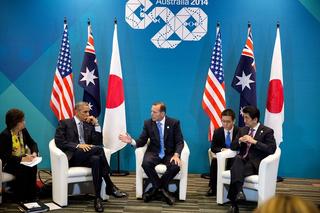
AUSMIN 2020 represented a major shift in aspirations when it consolidated the 2018 intent to refocus the Alliance on the Indo-Pacific over the Middle East, which had pulled focus for the previous two decades. This aligned with the strategic priorities of Australia’s Foreign Policy white paper (2017) and America’s National Defense Strategy (2018). The 2020 AUSMIN communique was the first since 9/11 to not mention Afghanistan, Iraq, Syria or Iran by name.
The areas of concern may change from meeting to meeting at AUSMIN but the common purpose and understanding do not.
As Australian Foreign Minister Marise Payne noted at the 2020 AUSMIN, although Australia and the United States are close allies, they ‘don’t agree on everything though – and that’s part of a respectful relationship.’43
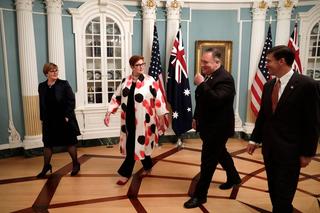
Major General Duncan Lewis AO DSC CSC
Director-General of Security (2014-19), Australian Ambassador to Belgium, Luxembourg, the European Union and NATO (2012-14), Secretary of the Department of Defence (2011-12), Major General, Australian Army (retired 2005)
A lifetime of work both in and out of uniform in the national security space has given me what some might consider a rare opportunity to see the Alliance in operation.
I have had the privilege to live the Alliance at all levels, from junior infantry officer to Secretary of the Department of Defence, from Ambassador to NATO to National Security Advisor and intelligence agency head. I have worked the Alliance from Afghanistan to the South China Sea and from the foxhole to the National Security Committee of Cabinet table.
In 2011, in San Francisco, we marked the 60th anniversary of the ANZUS signing ceremony at the Presidio, the very place where the original treaty was signed in 1951. As the Secretary of Defence, I sat at the table watching the relationship and the friendship between the Australian delegation and our opposite numbers on the US side. It was very special. We, of course, spoke at that meeting of operations in Afghanistan.
My mind drifted back momentarily to the night a decade earlier, at Khandahar Airport, where at the back of a burned-out aircraft hangar, I handed over the deployed Australian SAS Squadron to the operational control of Brigadier Jim Mattis. I was Commander of Australian Special Operations and travelling at the time with General Peter Cosgrove, the Chief of Army.

I recall saying to General Mattis, ‘I am entrusting our Australian soldiers to your command and your care – please look after them.’ Several weeks later, safely back in my headquarters, I received a wonderful hand-written note from Mattis saying I should have no concern, he would look after my soldiers as he would his own – and he did. It was a very touching note but the exchange reflected the deeply entrenched trust that existed between our two forces.
Today, my son is deployed on operations in the Middle East. He is a young officer embedded in a US unit and under another US commander. I know that as General Mattis looked after my soldiers, my son too will be treated like ‘their own.’ Such is the depth of the Alliance.
ANZUS, like all successful and enduring alliances, depends on shared interests and deep trust. We have these characteristics in great measure. The United States and Australia can readily share intelligence, synchronise and coordinate their security and defence policies, ensure commonality of equipment and develop and adopt doctrines to facilitate military interoperability.
However, the best measure of the Alliance I saw over my long association with it was witnessing how, during operations in the Middle East, military personnel from our two forces could actually embed seamlessly in each other’s headquarters and units.
I recall a particular command video conference with one US deployed headquarters when Secretary Rumsfeld, who was on the line from Washington, expressed astonishment that an officer with a strange uniform and a funny voice was briefing him on a most sensitive and secret operation. It was of course a young Australian – and I leave it to you to imagine how the exchange went!
As we face the reality of the shifting geostrategic balance, particularly in the Indo-Pacific theatre, it is clear those shared interests and trust upon which we signed the ANZUS Treaty 70 years ago endure.
In my view, we need this Alliance now more than at any time during my working life. Our shared values and freedoms are under challenge and we will best meet this challenge together. The Alliance which has served us so well over the past 70 years will, I know, serve us well in the years ahead as we face the tests which are sure to come.





